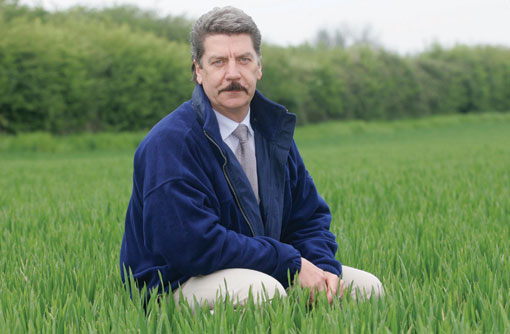Unleash more potential from wheat crops this season

Fungicide expert Bill Clark and commercial technical director at NIAB TAG has stood in a record-breaking crop of winter wheat and thought it “ordinary”.
This one wasn’t the current world record crop grown last season in New Zealand by Mike Solari, achieving 15.6 t/ha, but a previous winner grown there.
“It wasn’t a particularly thick crop, coming from 250 plants to achieve around 470 ears/sq m at harvest. It was a winner because this optimum population grew in favourable conditions and received well-placed inputs to maximise grain fill.”
It’s fair to say New Zealand growers have a distinct advantage over UK growers, with a plentiful water supply, higher radiation levels and much lower disease pressure. But Mr Clark believes we can get close to their record yields by managing the canopy, allowing optimum moisture and nutrient uptake and controlling diseases by optimising fungicide inputs. We also need a degree of luck during grain filling with bright sunny days and cool nights.
The input policy will depend partly on the resistance to disease in a variety. However, when choosing a variety for record yields, the first consideration should be genetic yield potential, he stresses.
| Bill Clark’s top five tips: |
|---|
| Get soil structure right |
| Make the most of current genetic potential |
| Optimise plant population |
| Manage fungivide inputs carefully |
| Maximise grain filling, possibly accepting later harvests |
The UK has some of the highest yielding varieties in the world, but there’s a serious gap between the yields achieved on farm and in Recommended List trials, he says.
“What’s interesting is that the record wheat crop last year was Einstein, a variety that’s more than 10 years old and roughly 10% lower yielding than the best varieties on our current RL. But with eye-watering amounts of nitrogen fertiliser – the winning crop received more than 500kg/ha – anything is possible. Just think of the potential with varieties like KWS Santiago, which is 1t/ha higher yielding than Einstein,” he says.
He acknowledges optimising rates, especially of fungicides, is not easy to do in season. So his advice is to over rather than under-dose for control of the main targets – septoria, and brown and yellow rust.
“We know the margin over input costs drops rapidly below the optimum, but is pretty flat above the optimum rate. Skimping on rates is dangerous because you run the risk of being sub-optimal. That is particularly true for the new SDHI fungicides.
“We don’t fully understand SDHIs yet, but we know they offer fantastic disease control plus additional yield over and above existing chemistry from direct effects on water and nitrogen utilisation, provided you use them at or near their optimum. Cut the rate and the yield advantage will disappear.”
When aiming for very high yields, he would use a half rate SDHI as leaf three is emerging (GS32), followed by a three-quarter rate of one of the newer products, Adexar (epoxiconazole and fluxapyroxad) or Aviator (prothioconazole and bixafen) at flag-leaf emergence (GS39).
Disease control is also particularly important during grain filling to maximise available green leaf area. The New Zealanders have naturally low disease levels, but we need to keep it going using fungicides, explains Mr Clark.
“We know that during grain filling in the UK, a wheat crop can put on 0.25t a day, so four extra days can give you an extra 1t/ha. Moisture limitations in the eastern counties may mean growers will struggle to keep crops going, however these very high yields are possible on deep silt soils where moisture isn’t limiting.”
The Scots, with their naturally long, cool grain filling periods, have the best chance of producing bumper yields. But to fully benefit, they must accept harvesting dates as late as the end of September.
“The UK’s highest yield will be one that has been kept green through August. The crop must have sufficient water and nitrogen to utilise this photosynthetic capability, which means getting the soil structure right for deep rooting.”

